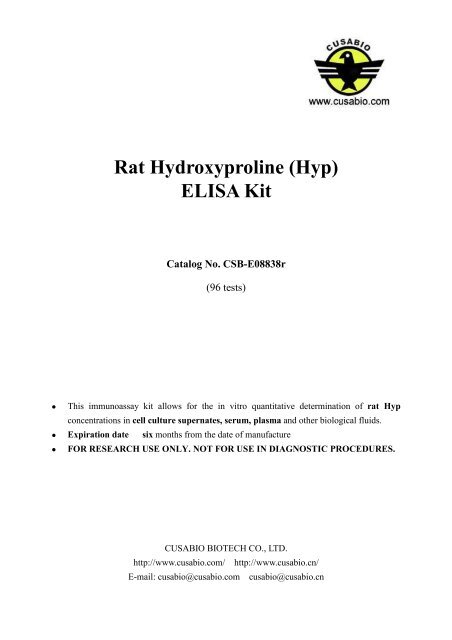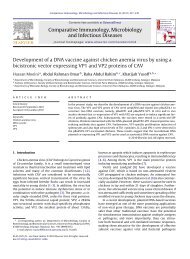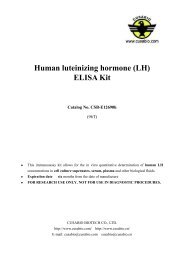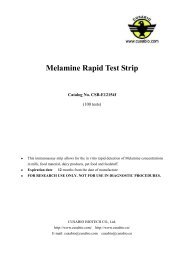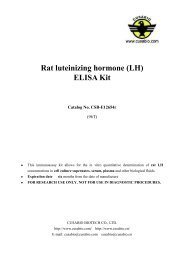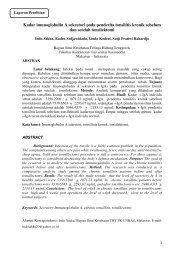Rat Hydroxyproline (Hyp) ELISA Kit
Rat Hydroxyproline (Hyp) ELISA Kit
Rat Hydroxyproline (Hyp) ELISA Kit
Create successful ePaper yourself
Turn your PDF publications into a flip-book with our unique Google optimized e-Paper software.
<strong>Rat</strong> <strong>Hydroxyproline</strong> (<strong>Hyp</strong>)<br />
<strong>ELISA</strong> <strong>Kit</strong><br />
Catalog No. CSB-E08838r<br />
(96 tests)<br />
<br />
This immunoassay kit allows for the in vitro quantitative determination of rat <strong>Hyp</strong><br />
concentrations in cell culture supernates, serum, plasma and other biological fluids.<br />
Expiration date six months from the date of manufacture<br />
<br />
FOR RESEARCH USE ONLY. NOT FOR USE IN DIAGNOSTIC PROCEDURES.<br />
CUSABIO BIOTECH CO., LTD.<br />
http://www.cusabio.com/ http://www.cusabio.cn/<br />
E-mail: cusabio@cusabio.com cusabio@cusabio.cn
INTRODUCTION<br />
4-<strong>Hydroxyproline</strong> (<strong>Hyp</strong>), or hydroxyproline (C5H9O3N), is an uncommon amino acid.<br />
<strong>Hydroxyproline</strong> differs from proline by the presence of a hydroxyl (OH) group attached to the<br />
C (gamma) atom. <strong>Hydroxyproline</strong> is produced by hydroxylation of the amino acid proline by<br />
the enzyme prolyl hydroxylase following protein synthesis (as a post-translational<br />
modification). The enzyme catalysed reaction takes place in the lumen of the endoplasmic<br />
reticulum. <strong>Hydroxyproline</strong> is a major component of the protein collagen. <strong>Hydroxyproline</strong> and<br />
proline play key roles for collagen stability. They permit the sharp twisting of the collagen<br />
helix. In the canonical collagen Xaa-Yaa-Gly triad (where Xaa and Yaa are any amino acid), a<br />
proline occupying the Yaa position is hydroxylated to give a Xaa-<strong>Hyp</strong>-Gly sequence. This<br />
modification of the proline residue increases the stability of the collagen triple helix. It was<br />
initially proposed that the stabilization was due to water molecules forming a hydrogen<br />
bonding network linking the prolyl hydroxyl groups and the main-chain carbonyl groups. It<br />
was subsequently shown that the increase in stability is primarily through stereoelectronic<br />
effects and that hydration of the hydroxyproline residues provides little or no additional<br />
stability. <strong>Hydroxyproline</strong> is found in few proteins other than collagen. The only other<br />
mammalian protein which includes hydroxyproline is elastin. For this reason, hydroxyproline<br />
content has been used as an indicator to determine collagen and/or gelatin amount.<br />
PRINCIPLE OF THE ASSAY<br />
The microtiter plate provided in this kit has been pre-coated with an antibody specific to <strong>Hyp</strong>.<br />
Standards or samples are then added to the appropriate microtiter plate wells with a<br />
biotin-conjugated polyclonal antibody preparation specific for <strong>Hyp</strong> and Avidin conjugated to<br />
Horseradish Peroxidase (HRP) is added to each microplate well and incubated. Then a TMB<br />
(3,3',5,5' tetramethyl-benzidine) substrate solution is added to each well. Only those wells that<br />
contain <strong>Hyp</strong>, biotin-conjugated antibody and enzyme-conjugated Avidin will exhibit a change<br />
in color. The enzyme-substrate reaction is terminated by the addition of a sulphuric acid<br />
solution and the color change is measured spectrophotometrically at a wavelength of 450 nm ±<br />
2 nm. The concentration of <strong>Hyp</strong> in the samples is then determined by comparing the O.D. of<br />
the samples to the standard curve.<br />
DETECTION RANGE<br />
156 ng/ml-10000 ng/ml. The standard curve concentrations used for the <strong>ELISA</strong>’s were 10000<br />
ng/ml, 5000 ng/ml, 2500 ng/ml, 1250 ng/ml, 625 ng/ml, 312 ng/ml, 156 ng/ml.<br />
SPECIFICITY<br />
This assay recognizes recombinant and natural rat <strong>Hyp</strong>. No significant cross-reactivity or<br />
interference was observed.
SENSITIVITY<br />
The minimum detectable dose of rat <strong>Hyp</strong> is typically less than 39 ng/ml.<br />
The sensitivity of this assay, or Lower Limit of Detection (LLD) was defined as the lowest<br />
protein concentration that could be differentiated from zero.<br />
MATERIALS PROVIDED<br />
Reagent<br />
Quantity<br />
Assay plate 1<br />
Standard 2<br />
Sample Diluent<br />
Biotin-antibody Diluent<br />
HRP-avidin Diluent<br />
1 x 20 ml<br />
1 x 10 ml<br />
1 x 10 ml<br />
Biotin-antibody 1 x 120µl<br />
HRP-avidin 1 x 120µl<br />
Wash Buffer<br />
TMB Substrate<br />
1 x 20 ml<br />
(25×concentrate)<br />
1 x 10 ml<br />
Stop Solution<br />
1 x 10 ml<br />
STORAGE<br />
1. Unopened test kits should be stored at 2-8°C upon receipt and the microtiter plate should be<br />
kept in a sealed bag with desiccants to minimize exposure to damp air. The test kit may be<br />
used throughout the expiration date of the kit. Refer to the package label for the expiration<br />
date.<br />
2. Opened test kits will remain stable until the expiring date shown, provided it is stored as<br />
prescribed above.<br />
3. A microtiter plate reader with a bandwidth of 10 nm or less and an optical density range of<br />
0-3 OD or greater at 450nm wavelength is acceptable for use in absorbance measurement.<br />
REAGENT PREPARATION<br />
Bring all reagents to room temperature before use.<br />
1. Wash Buffer If crystals have formed in the concentrate, warm up to room temperature<br />
and mix gently until the crystals have completely dissolved. Dilute 20 ml of Wash Buffer<br />
Concentrate into deionized or distilled water to prepare 500 ml of Wash Buffer.<br />
2. Standard Reconstitute the Standard with 1.0 ml of Sample Diluent. This reconstitution<br />
produces a stock solution of 10000 ng/ml. Allow the standard to sit for a minimum of 15
minutes with gentle agitation prior to making serial dilutions. The undiluted standard<br />
serves as the high standard (10000 ng/ml). The Sample Diluent serves as the zero<br />
standard (0 ng/ml).<br />
3. Biotin-antibody Dilute to the working concentration specified on the vial label using<br />
Biotin-antibody Diluent(1:100), respectively.<br />
4. HRP-avidin Dilute to the working concentration specified on the vial label using<br />
HRP-avidin Diluent(1:100), respectively.<br />
Precaution: The Stop Solution provided with this kit is an acid solution. Wear eye, hand, face,<br />
and clothing protection when using this material.<br />
OTHER SUPPLIES REQUIRED<br />
<br />
<br />
<br />
<br />
Microplate reader capable of measuring absorbance at 450 nm, with the correction<br />
wavelength set at 540 nm or 570 nm.<br />
Pipettes and pipette tips.<br />
Deionized or distilled water.<br />
Squirt bottle, manifold dispenser, or automated microplate washer.<br />
SAMPLE COLLECTION AND STORAGE<br />
Cell Culture Supernates Remove particulates by centrifugation and assay immediately<br />
or aliquot and store samples at -20° C. Avoid repeated freeze-thaw cycles.<br />
Serum Use a serum separator tube (SST) and allow samples to clot for 30 minutes<br />
before centrifugation for 15 minutes at 1000 g. Remove serum and assay immediately or<br />
aliquot and store samples at -20° C. Avoid repeated freeze-thaw cycles.<br />
Plasma Collect plasma using citrate, EDTA, or heparin as an anticoagulant. Centrifuge<br />
for 15 minutes at 1000 g within 30 minutes of collection. Assay immediately or aliquot<br />
and store samples at -20° C. Avoid repeated freeze-thaw cycles.<br />
Note: Grossly hemolyzed samples are not suitable for use in this assay.<br />
ASSAY PROCEDURE<br />
Bring all reagents and samples to room temperature before use. It is recommended that all<br />
samples, standards, and controls be assayed in duplicate.<br />
1. Add 100µl of Standard, Blank, or Sample per well. Cover with the adhesive strip. Incubate<br />
for 2 hours at 37° C.<br />
2. Remove the liquid of each well, don’t wash.<br />
3. Add 100µl of Biotin-antibody working solution to each well. Incubate for 1 hour at 37°C.<br />
Biotin-antibody working solution may appear cloudy. Warm up to room temperature and
mix gently until solution appears uniform.<br />
4. Aspirate each well and wash, repeating the process three times for a total of three washes.<br />
Wash by filling each well with Wash Buffer (200µl) using a squirt bottle, multi-channel<br />
pipette, manifold dispenser or autowasher. Complete removal of liquid at each step is<br />
essential to good performance. After the last wash, remove any remaining Wash Buffer by<br />
aspirating or decanting. Invert the plate and blot it against clean paper towels.<br />
5. Add 100µl of HRP-avidin working solution to each well. Cover the microtiter plate with a<br />
new adhesive strip. Incubate for 1 hour at 37°C.<br />
6. Repeat the aspiration and wash three times as step 4.<br />
7. Add 90µl of TMB Substrate to each well. Incubate for 10-30 minutes at 37°C. Keeping<br />
the plate away from drafts and other temperature fluctuations in the dark.<br />
8. Add 50µl of Stop Solution to each well when the first four wells containing the highest<br />
concentration of standards develop obvious blue color. If color change does not appear<br />
uniform, gently tap the plate to ensure thorough mixing.<br />
9. Determine the optical density of each well within 30 minutes, using a microplate reader set<br />
to 450 nm.<br />
CALCULATION OF RESULTS<br />
Average the duplicate readings for each standard, control, and sample and subtract the average<br />
zero standard optical density. Create a standard curve by reducing the data using computer<br />
software capable of generating a four parameter logistic (4-PL) curve-fit. As an alternative,<br />
construct a standard curve by plotting the mean absorbance for each standard on the y-axis<br />
against the concentration on the x-axis and draw a best fit curve through the points on the<br />
graph. The data may be linearized by plotting the log of the <strong>Hyp</strong> concentrations versus the log<br />
of the O.D. and the best fit line can be determined by regression analysis. This procedure will<br />
produce an adequate but less precise fit of the data. If samples have been diluted, the<br />
concentration read from the standard curve must be multiplied by the dilution factor.<br />
LIMITATIONS OF THE PROCEDURE<br />
<br />
<br />
<br />
<br />
<br />
<br />
The kit should not be used beyond the expiration date on the kit label.<br />
Do not mix or substitute reagents with those from other lots or sources.<br />
It is important that the Calibrator Diluent selected for the standard curve be consistent with<br />
the samples being assayed.<br />
If samples generate values higher than the highest standard, dilute the samples with the<br />
appropriate Calibrator Diluent and repeat the assay.<br />
Any variation in Standard Diluent, operator, pipetting technique, washing technique,<br />
incubation time or temperature, and kit age can cause variation in binding.<br />
This assay is designed to eliminate interference by soluble receptors, binding proteins, and
other factors present in biological samples. Until all factors have been tested in the<br />
Quantikine Immunoassay, the possibility of interference cannot be excluded.<br />
TECHNICAL HINTS<br />
<br />
<br />
<br />
<br />
<br />
<br />
When mixing or reconstituting protein solutions, always avoid foaming.<br />
To avoid cross-contamination, change pipette tips between additions of each standard level,<br />
between sample additions, and between reagent additions. Also, use separate reservoirs for<br />
each reagent.<br />
When using an automated plate washer, adding a 30 second soak period following the<br />
addition of wash buffer, and/or rotating the plate 180 degrees between wash steps may<br />
improve assay precision.<br />
To ensure accurate results, proper adhesion of plate sealers during incubation steps is<br />
necessary.<br />
Substrate Solution should remain colorless until added to the plate. Keep Substrate<br />
Solution protected from light. Substrate Solution should change from colorless to<br />
gradations of blue.<br />
Stop Solution should be added to the plate in the same order as the Substrate Solution. The<br />
color developed in the wells will turn from blue to yellow upon addition of the Stop<br />
Solution. Wells that are green in color indicate that the Stop Solution has not mixed<br />
thoroughly with the Substrate Solution.


